Durham University Library
The Durham University Library is the centrally administered library of Durham University in England. It was founded in January 1833 at Palace Green by a 160 volume donation by the then Bishop of Durham, William Van Mildert, and now holds over 1.6 million printed items.[3] The University Library comprises five separate libraries:
- Bill Bryson Library (the Main Library) [4]
- Leazes Road Library
- Palace Green Library
- International Study Centre Library at Queen's Campus
- Durham Business School Library
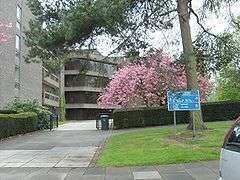 | |
| Country | United Kingdom |
|---|---|
| Type | University Library |
| Established | 1833 |
| Location | Durham, England |
| Branches | 5 (Excluding the College Libraries) |
| Collection | |
| Items collected | Books, journals, newspapers, magazines, sound and music recordings, patents, databases, maps, Parliamentary papers, Mediaeval Seals, European Union Papers, Ecclesiastical Records, Middle East Papers, drawings and manuscripts |
| Size | >1,637,000 printed items, 19,500 e-journals and more than 313,000 e-books. (Excluding the College Libraries).[1] |
| Access and use | |
| Access requirements | Open to all students of Durham Students from universities within the SCONUL Vacation Access Scheme. NHS Staff (Northern Region). Certain external borrowers, alumni and fee-payers. |
| Other information | |
| Budget | £4.4M (2013-14)[2] |
| Director | Jon Purcell |
| Website | Dur.ac.uk/library |
| Map | |
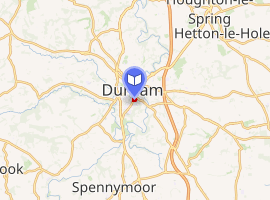
| |
History
Cosin's Library
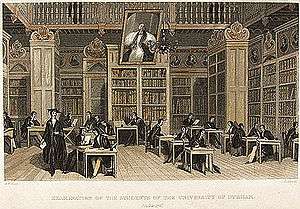
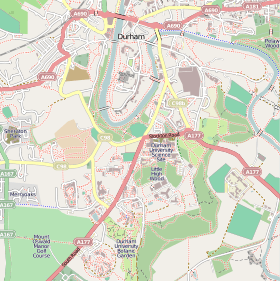
After the donation by Bishop William Van Mildert, a suitable location to house the library's stock had to be founded and thus a gallery had to be constructed onto the Cosin's Library (a Diocesan library founded in 1669 by Bishop John Cosin located on Palace Green) in 1834. The original Cosin's library is still located at Palace Green and along with its collection of medieval manuscripts, and early printed books came under the trusteeship of the University Library in 1937.
Cosin's Library is a grade one listed building and is located in a UNESCO World Heritage Site. The internal architecture and decoration are also of international importance. The original portrait panels located above the bookshelves were painted by Jan Baptist van Eerssell in 1668–1669. Further portraits hang in the library, including half portraits of English statesmen. Nearly three hundred years later, a former University Librarian, David Ramage, completed Cosin's original plan for the library by painting further portrait panels for the smaller room added in 1670–1671.
In October 2005, the Museums, Libraries and Archives Council designated the collections in Cosin's Library as having an "outstanding national and international significance".
Expansion
Additional bequeathed or donated collections during the 1850s (most notably by Martin Routh in 1854, Edward Maltby in 1856 and Thomas Mastermann Winterbottom in 1859) led to a further expansion of the library, with the upper two floors of the Exchequer Building (former Bishoprick Law Courts from 1450) being occupied. As the library's stock further expanded, more space was gradually needed, with a nineteenth-century lecture block eventually becoming part of the library. A major extension to the Palace Green Library in 1966 designed by architect George Pace provided a reading room and new storage space for the University Library. With no possibility of further expansion on the peninsula, the decision was taken to extend the library building on the university's science site, which became the Main Library in 1983.
Recent history

The University Library has undergone many developments since the 1980s, with the first online circulation system being introduced in 1983, the Main Library won a SCONUL Library Design Award in 1988 and the online cataloguing of the library's stock beginning in 1990. In 1996 the Durham University Library also joined the Consortium of Research Libraries in the British Isles (now Research Libraries UK).
In the succeeding years, the University Library was expanded further with an extension of the main library in 1997 and also became the first library in 1998 to incorporate non-Roman scripts into its electronic catalogue system. Further in 2004, the Durham Cathedral Library became part of the University Library's management system for circulation and lending. A further major extension of the Main Library opened in 2012, and shortly afterwards the building was renamed the Bill Bryson Library.[3]
List of past librarians
- 1832–1834 – Patrick George
- 1834–1855 – Charles Thomas Whitley
- 1856–1858 – Robert Healey Blakey
- 1858–1864 – Henry Frederick Long
- 1865–1868 – Francis Frederick Walrond
- 1869–1873 – Thomas Forster Dodd
- 1873–1901 – Joseph Thomas Fowler
- 1901–1934 – Edward Vazeille Stocks
- 1934–1945 – Henry Waldo Acomb
- 1940–1943 – Beatrice Thompson (Acting Librarian)
- 1945–1967 – David Goudie Ramage
- 1967–1989 – Agnes Maxwell McAulay
- 1989–2009 – John Tristan Dalton Hall
- 2009–2017 – Jon Purcell
Heritage, research and special collections
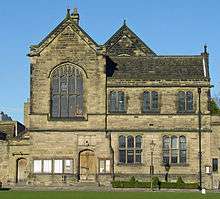
As part of its collection, the library contains a wealth of printed and manuscript material with a particular wealth of material from the medieval period and the Middle East along with materials from the North East. These include:
- Middle East and Islamic Studies collections: One of the most important collections in the UK, it contains over 50,000 monographs and over 2,500 periodicals covering the Ottoman Empire to ancient Mesopotamian archaeology to modern Persian literature.
- The Sudan Archive: founded in 1957, the year after Sudanese independence, to collect and preserve the papers of administrators from the Sudan Political Service, missionaries, soldiers, business men, doctors, agriculturalists, teachers and others who had served or lived in the Sudan (now Sudan and South Sudan) during the Anglo-Egyptian Condominium (1898–1955). There is a significant amount of Mahdist material as well as papers relating to the military campaigns of the 1880s and 1890s, while in recent years, the scope of the Archive has extended to the period after independence and now contains material up to the present day. The Archive also holds substantial numbers of papers relating to Egypt, the Arabian Peninsula, Palestine, Transjordan, Syria, and African states bordering on Sudan and South Sudan. Most of the material is in English, with a small amount in Arabic. In 2005 the collection was accorded with designated status by the Museums, Libraries and Archives Council.[5]
- Abbas Hilmi II Papers, Khedive of Egypt 1892–1914.[6]
- Bamburgh Library Collection: Created in 1958, the collection holds some 8,500 manuscript and print titles, with 16 incunabula across a variety of subject areas. The collection was largely acquired during the mid-seventeenth and mid-eighteenth centuries by the Archbishop of York, John Sharp (1644–1714), along with three generations of the Sharp Family. The collection contains the 1533 edition of the Psalms from Freiburg and Joannes Guinterius's Anatomicarum institutionum libri.[7][8][9]
- Bibliotheca Episcopalis Dunelmensis (Cosin Collection): Founded in 1669 by the then Bishop John Cosin. The collection contains over 5,000 titles, including nine incunabula, over 600 foreign 16th-century titles. The collection is largely in French or German and based on theological issues such as Canon law and liturgy. The collection contains Cosin's 1568 Zürich edition of Heinrich Bullinger's De origine erroris.[7][10][11][12]
- Howard Collection: Contains the library of Lord William Howard of Naworth. The collection is largely of Roman Catholic texts, including a Vienna imprint of Stanislaus Hosius's Confessio catholicae fidei christiana of 1561.[13]
- Quakerism Collection: Acquired in 1972 from the surviving collection of the Sunderland Preparative Meeting of the Society of Friends Library and contains approx. 880 printed volumes and a number of related manuscripts.[7][14][15]
- Kellett Collection: Principally composed of the library of C. E. de M. Kellett, focusing on medicine and medical teaching. The collection contains a number of pre-18th century along with 16th and 17th-century works, including Aristotle's Totius naturalis philosophiae Aristotelis paraphrases and Galen's De sanitate tuenda alongside Vidius's Chirurgia and Estienne's De Dissectione.[7][16]
- Routh Collection: Is the library of Martin Joseph Routh, president of Magdalen College, Oxford. The collection is in two sections the first on early Church Fathers entitled Reliquiae sacrae and his edition of Gilbert Burnet's History of his own time. Of the incunabula one of the most notable is Breydenbach's Itinerarium in terram sanctam. The collection contains a wealth of dating from the 14th century.[7][17][18]
- St Chad's Collection: Deposited by St Chad's College, it contains a number of 16th and 17th-century imprints, including Quintus Aurelius Symmachus's Epistolae familiares and the Concilia omnia.[7][19]
- Basil Bunting Poetry Archive: Acquired in 1987 with grants from the National Heritage Memorial Fund and the Purchase Grant Fund. It is the most extensive collection in the UK of the work of Basil Bunting (1900–1985) and of material relating to him.[20]
- Pratt Green Collection: Is a collection founded in 1987 and contains an extensive array of hymns and hymnology. The collection was with a gift from the Pratt Green Trustees and contains work from the distinguished hymn writer, Fred Pratt Green.[21]
- Malcolm MacDonald Papers: Papers covering the life of the former politician and chancellor of the university.[22]
- Earl Grey Collection: Contains extensive works and papers of the former prime minister.[23]
- Durham University Observatory Records: Contains the second-longest meteorological record in the UK from 1839 to 1953, also contains records of other local observatories.[24]
- Medieval Seals: The collection contains many Royal and ecclesiastic devices, including Duncan I king of Scots, Henry III king of England, first great seal, and the seal of Pope Martin IV.[25][26]
Partnerships
The University Library is a member of several organisation, including:
- Research Libraries UK
- The Association of European Research Libraries
- The Middle East Libraries Committee (UK)
- The North East Museums Libraries and Archives Council
- Research Libraries Group
- Society of College, National and University Libraries
See also
References
- "About the University Library and Heritage Collections". Durham University Library. Retrieved 6 February 2016.
- "Key Annual Data". Durham University Library. Retrieved 6 February 2016.
- University Library. "University Library : Library History – Durham University". Dur.ac.uk. Retrieved 2017-06-01.
- "The Main Library is being renamed 'The Bill Bryson Library'!". Durham University. 2012-09-25. Retrieved 2012-11-27.
- "Special Collections : The Sudan Archive at Durham – Durham University". www.dur.ac.uk. Retrieved 2017-12-11.
- Collection Level Description: Abbas Hilmi II Papers, 1834, retrieved 2017-12-11
- "Wissenschaftsportal b2i: Bestandserhaltung". B2i.de. Retrieved 2017-06-01.
- "Special Collections : Bamburgh Library – Durham University". www.dur.ac.uk. Retrieved 2017-12-21.
- Collection Level Description: Bamburgh Library Manuscripts, retrieved 2017-12-21
- Collection Level Description: Bishop Cosin's Library, 1400, retrieved 2017-12-21
- Collection Level Description: Cosin Letter-Books, 1593, retrieved 2017-12-21
- Collection Level Description: Cosin Manuscripts, 1000, retrieved 2017-12-21
- Collection Level Description: Howard Library, 1488, retrieved 2017-12-21
- Collection Level Description: Sunderland Friends Library, 1655, retrieved 2017-12-21
- Collection Level Description: Sunderland Friends' Manuscripts, 1800, retrieved 2017-12-21
- Collection Level Description: Kellett Collection, 1500, retrieved 2017-12-21
- Collection Level Description: Routh Library, 1450, retrieved 2017-12-21
- Collection Level Description: Routh Manuscripts, 1100, retrieved 2017-12-21
- Collection Level Description: St. Chad's College MSS, 1200, retrieved 2017-12-21
- Collection Level Description: Basil Bunting Poetry Archive, 1900, retrieved 2017-12-21
- Collection Level Description: Pratt Green Collection, 1700, retrieved 2017-12-21
- Collection Level Description: Malcolm MacDonald Papers, 1901, retrieved 2017-12-21
- Collection Level Description: Earl Grey Family Papers, 1500, retrieved 2017-12-21
- Collection Level Description: Durham University Observatory Records, 1839, retrieved 2017-12-21
- "Catalogue of the medieval seals in the Durham Cathedral Muniments". reed.dur.ac.uk. Retrieved 2017-12-21.
- "Durham University Library – Medieval Seals". valentine.dur.ac.uk. Retrieved 2017-12-21.

